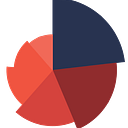Minimal one-way and two-way summary tables using in R
Summary tables are essential for exploring and presenting data in a concise and informative manner. In R, packages like gtsummary,janitor andsjPlot provide super user-friendly syntax to create visually appealing summary tables. In this blogpost, we will see how to use them to generate beautiful one-way and two-way summary tables.
Let's load the packages:
library(janitor) #for the tabyl function
library(sjPlot) #for the tab_xtab function
library(gtsummary) #for the tbl_cross functionOne-Way Summary Table:
A one-way summary table displays the distribution of a single variable. Here is how to make one using the janitor package (data from diamonds dataset):
diamonds %>% tabyl(cut) %>% flextable()Two-Way (crosstabulation) tables using sjPlot:
A two-way table displays the distribution of a variable by the categories of another. Here is how to make one using the tabyl function from the janitor package:
diamonds %>% tabyl(cut, color, show_na = FALSE) %>%
adorn_percentages("row") %>%
adorn_pct_formatting(digits = 2) %>%
adorn_ns() %>% flextable()And another using the tab_xtab from sjPlot
library(sjPlot)
sjPlot::tab_xtab(var.row = diamonds$cut, var.col = diamonds$color,
title = "Table Title", show.row.prc = TRUE)A beautiful summary table that displays both freq and percentage distribution along with a bunch of independence tests.
Next, we will make a two-way table calculating the row percentage with gtsummary package:
diamonds %>%
select(cut,color) %>%
tbl_cross(row = cut,
col = color,
percent = "cell",
missing = "no")Lastly, we will repeat the process to make multiple two-way tables using a loop as requested by a friend:
vars <- c("carat", "cut" ) # select the target row vars
table_list <- list()
for(var in vars) {
tbl <- diamonds %>%
select(color, {{ var }}) %>% #remember to select the col var
tbl_cross(
row = {{ var }},
col = color,
percent = "cell",
missing = "no" )
table_name <- paste0("table_", var)
table_list[[table_name]] <- tbl
}Print the table list:
> table_list
$table_carat
$table_cutNow we can view the first table:
(output omitted to screenshot space constraints)
print(table_list[["table_carat"]])And the second one:
print(table_list[["table_cut"]])Really cool aren’t they? Must be good enough for making journal articles or professional reports.
Happy tabulating, and a happy new year from infoart!
